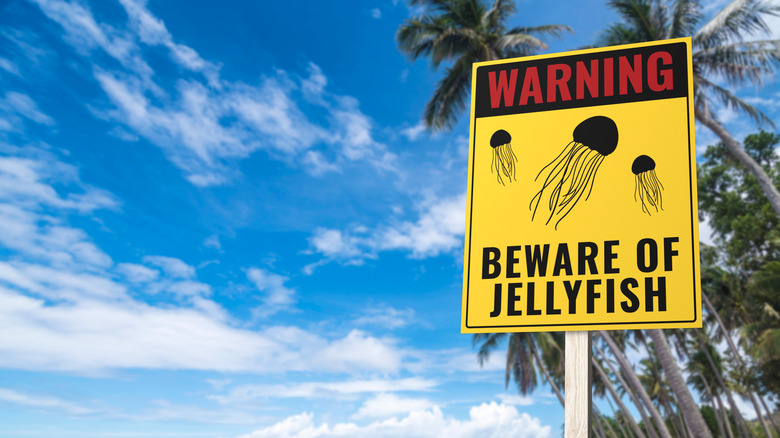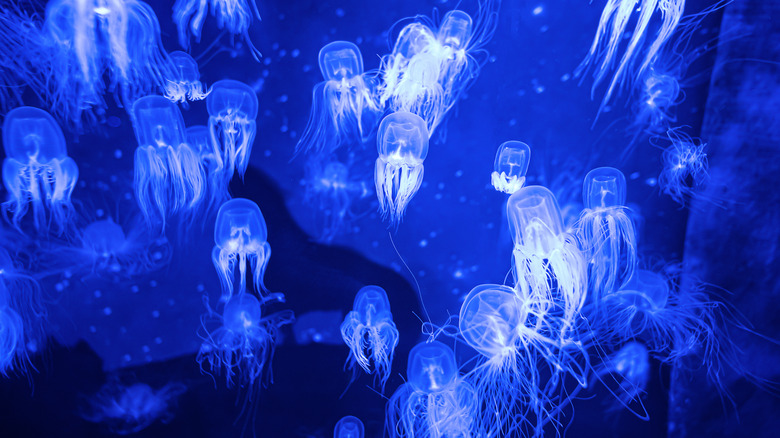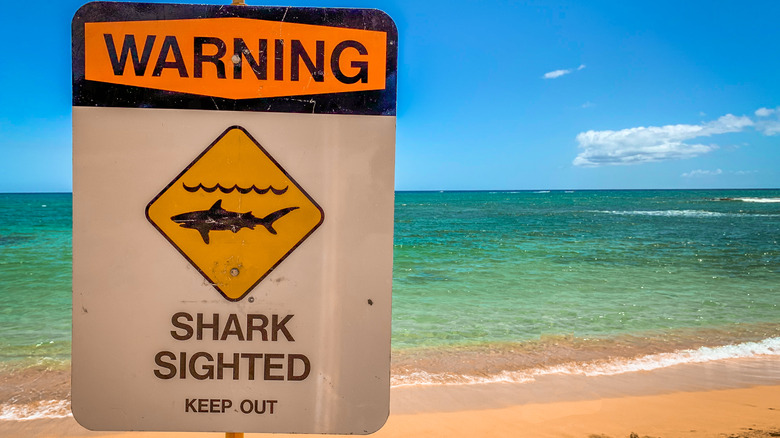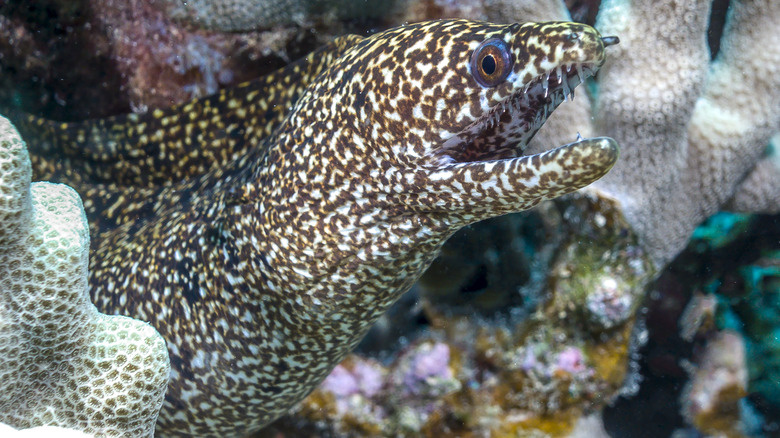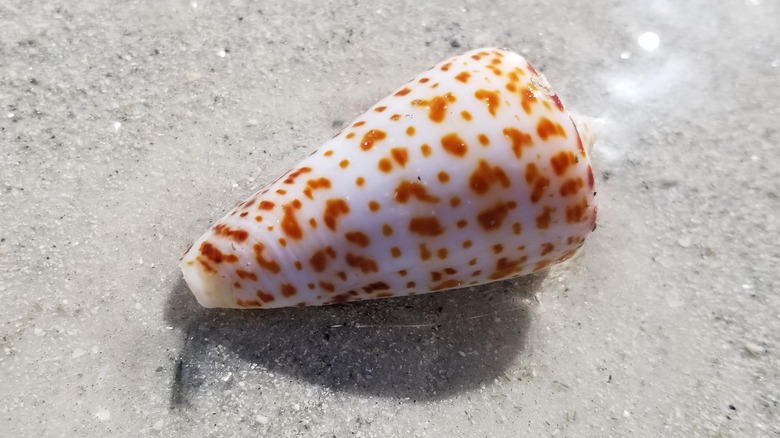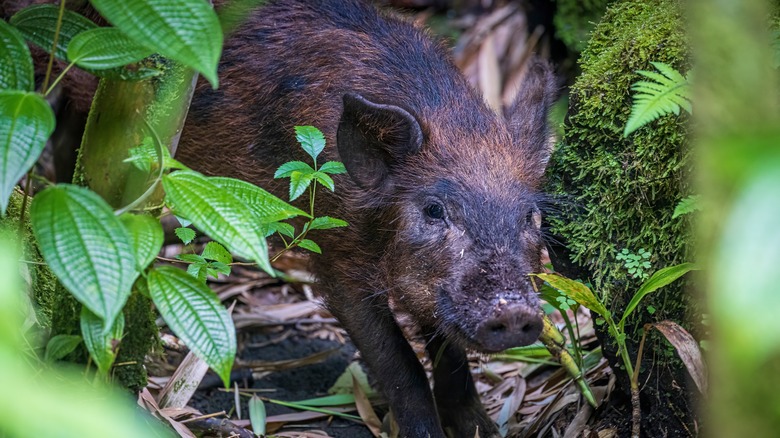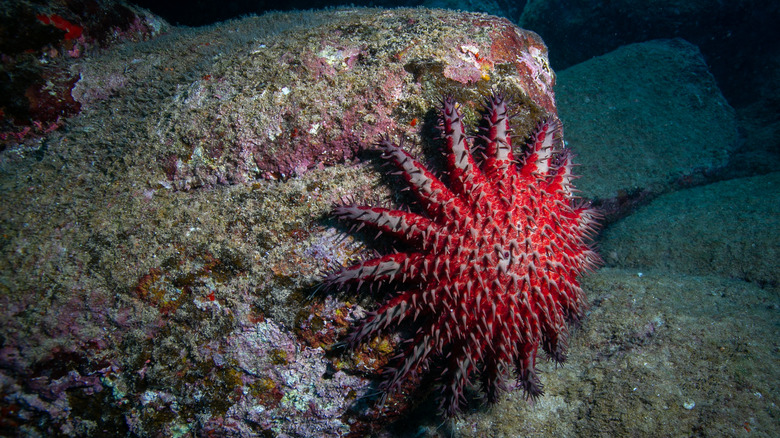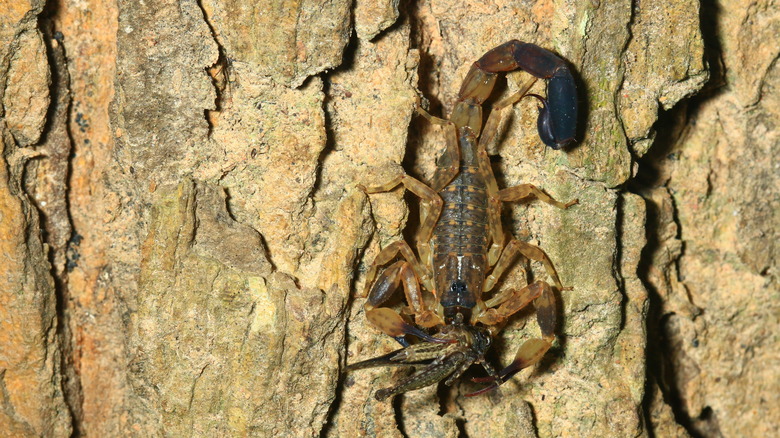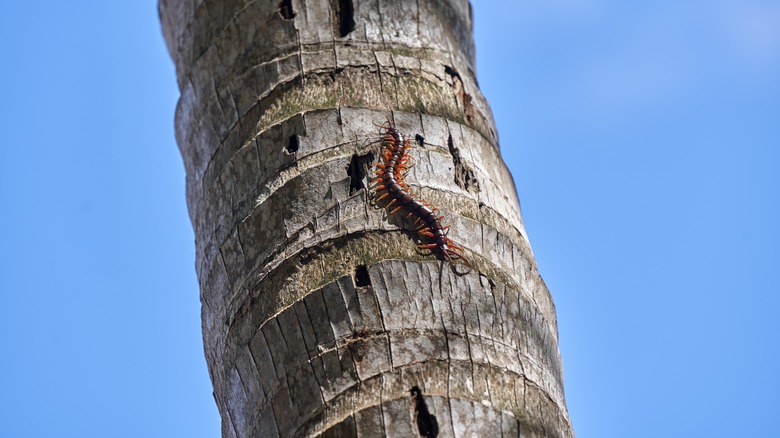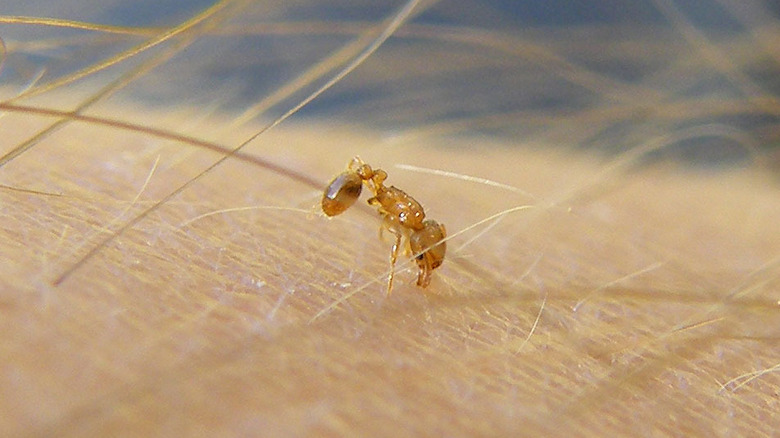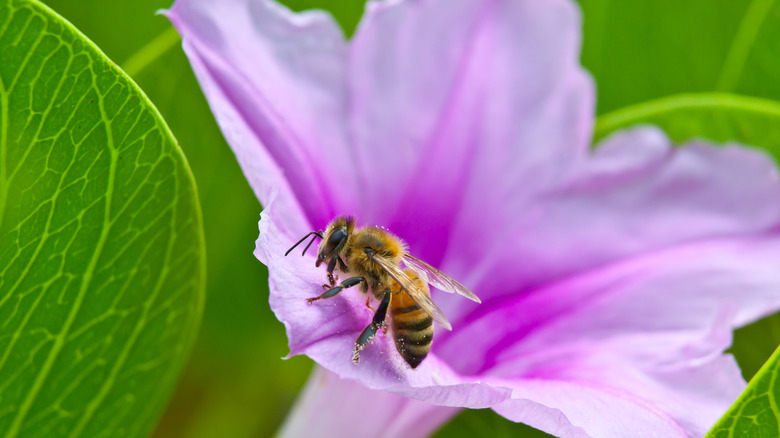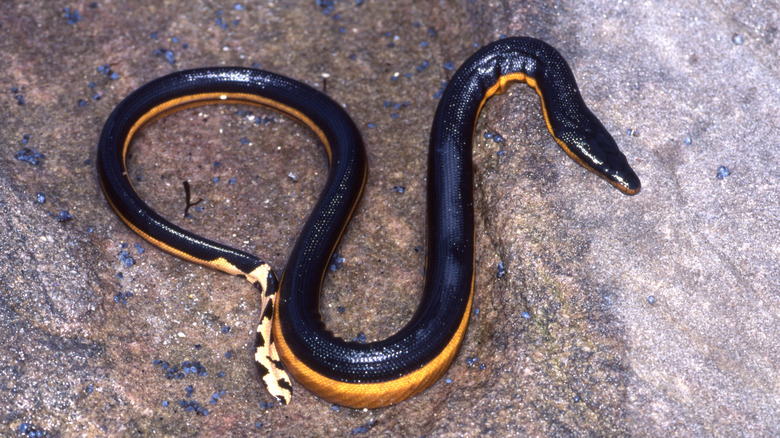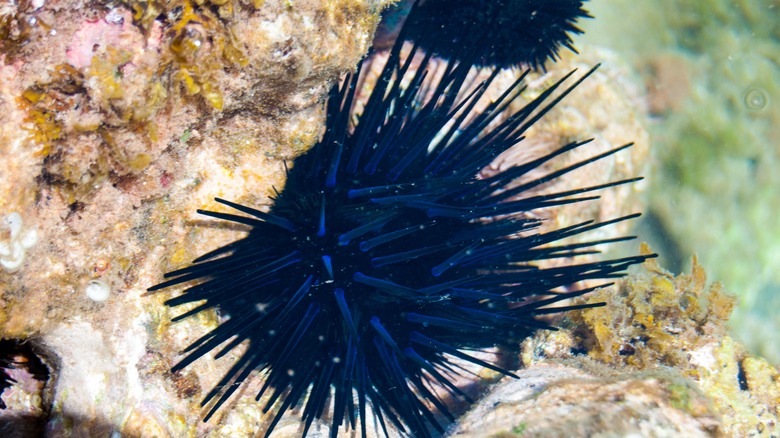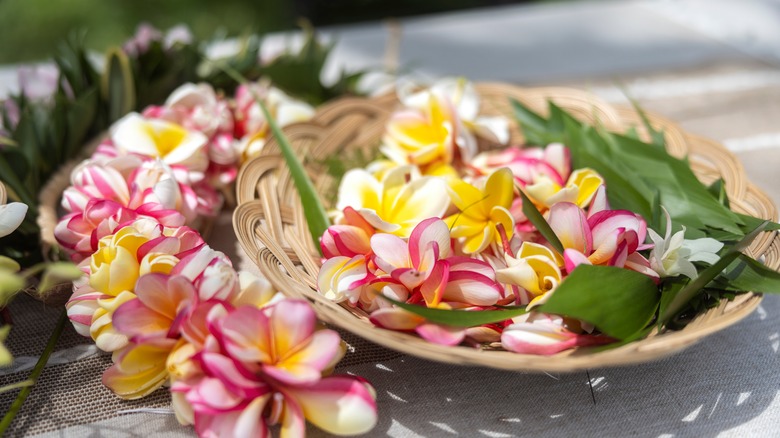The Most Dangerous Wildlife To Watch Out For On Your Vacation In Hawaii
The scariest things you'll encounter on a trip to Hawaii are probably sunburns and deciding which flavor of Hawaiian shave ice to try next. But to play it safe, some of the Aloha State's wildlife deserves a mention. On land, you'll want to be aware of some creepy crawlers like centipedes. In the ocean, be mindful of aquatic dangers, such as sea urchins. And mosquitoes are common, so pack some repellant.
While some of Hawaii's wildlife are among the most dangerous animals in the world, the species found on the islands are often less dangerous than their relatives. For example, a sting from a box jellyfish elsewhere might send you rushing to the emergency room, but in Hawaii, it might not even require a doctor's visit. Similarly, while some scorpion species have venom with dangerous neurotoxins, the scorpions in Hawaii don't have neurotoxins, and serious symptoms from stings are rare. Learn about these local inhabitants and respect their space, and you'll have a fantastic trip to Hawaii.
Jellyfish
Beware of the jellyfish — nature's squishy surprise. These gelatinous party crashers are regulars in Hawaii's waters, turning your perfect beach day into an "ouch" moment. However, while their stings can pack a punch, they're rarely life-threatening.
Hawaii sees its fair share of box jellyfish. In other parts of the world, box jellyfish are some of the most venomous jellyfish in existence, causing more deaths than sharks. Luckily, the Hawaiian variety poses much less risk. Still, their painful sting is a good reason to avoid jellyfish on your Hawaiian vacation. To do so, pay attention to full moons — box jellyfish seem to have their own lunar calendar. They usually make their grand entrance eight to 10 days after a full moon.
On January 16, 2023 — 10 days after the full moon — 156 people got an unwelcome "hello" from box jellyfish along Oahu's southern shore. A 15-year-old boy had to be taken to the hospital for treatment. But these mass jellyfish events are more of an exception than a rule, and most stings don't require a trip to the emergency room. If you do get stung, you may hear differing treatment ideas, but both WebMD and the University of Hawaii recommend rinsing the area with vinegar to neutralize the sting and removing tentacles with tweezers. Call 911 if you develop signs of a severe allergic reaction or if the sting covers more than half an arm or a leg.
Sharks
Before envisioning scenes from the classic movie "Jaws," let's set the record straight: sharks aren't lurking around every coral reef with a personal vendetta against humans. In Hawaii, we can take an added sigh of relief because the great white shark — one of the ocean's great predators and the star of "Jaws" — rarely visits Hawaii's waters. Other sharks frequent the area but encounters with humans are rare — shark experts like to point out that you're more likely to meet your end under a falling coconut than in the jaws of a shark.
While shark attacks are rare, understanding shark behavior can reduce the already small risk. Timing is everything. According to the Division of Aquatic Resources, Hawaii Department of Land and Natural Resources, many of the state's most severe attacks happen in November and December, when fewer humans are swimming in the waters. Also, some sharks tend to move inshore for feeding at dawn, dusk, and night, so swim during daylight rather than shark happy hour.
When you do enjoy the water, consider a few tips to keep yourself safer, such as keeping to designated areas, avoiding murky waters, and steering clear of fishing areas. A shark might mistake shiny jewelry for the shimmer of fish scales, so leave your bling at home. As a rule, if there's a shark sighting or warning, get out and stay out of the water.
Eels
Eels in Hawaii might look like they're auditioning for the role of a villain in an underwater thriller, but in reality, they're more like the shy kids in the sea school. They prefer to play hide and seek in crevices, only appearing when curiosity or hunger calls. Despite their elusive nature, eels can be protective of their space, and this territorial streak sometimes leads to close encounters of the nippy kind.
Though rare, an eel bite can cause a lot of damage — so much damage that they're sometimes mistaken for shark bites. Back in 2015, a bite sent a surfer from the shores of Waikiki Beach to the hospital. Hawaii's Department of Land and Natural Resources launched an investigation and consulted a shark expert before confirming that the bite was from an eel and not a shark.
In 2018, an eel bit a woman at Kuhio Beach. Given the amount of blood, some first suspected it was a shark bite. That attack happened while a woman was lounging on a floaty, but these types of unprovoked attacks are extremely rare. Most bites happen to divers who reach into a crevice or when someone attempts to feed an eel. In other words, you're likely safe if you respect marine life habitats and don't feed the fish.
Cone snails
Shaped like sleek ice cream cones (but please, don't try licking them!), cone snails come in various colors and intricate patterns. Imagine zigzags, fancy geometric designs, and subtle color gradations that make beachcombers go "Ooh!" and "Aah!" The size of these snails varies depending on the species, but many are relatively small, fitting comfortably in the palm of your hand, although don't put them in the palm of your hand. To describe that as "foolish" would be an understatement.
Beneath a cone snail's pretty exterior lies a harpoon-like tooth loaded with venom that can make a fish wish it had never been in the water. Occasionally, an unlucky human gets a feel for this underwater weaponry. Hawaii has over 30 types of cone snails, including the textile cone snail, one of the most toxic species.
Human versus snail showdowns are rare. Most times, a sting from these little rascals needs nothing more than a good scrub. It might feel like a bee sting, with some soreness and numbness. However, if symptoms such as nausea, headache, or difficulty breathing follow a sting, it's time for immediate medical attention. To avoid this risk, if you're beachcombing, treat every shell as if it's housing a cone snail. Leave these shells on the beach, where they add to the scenery and don't require an emergency room visit. And when in Hawaiian waters, admire these snails from a distance.
Feral pigs
In the lush paradise of Hawaii roams an often-overlooked inhabitant: the feral pig. Also known as feral swine, wild boar, or wild hog, these are descendants of escaped or released farm pigs. While generally not the type to start a ruckus, feral pigs can get feisty if they feel boxed in, threatened, or hurt, or if they're protecting their piglets. Pigs bite, and their tusks are sharp enough to inflict severe wounds. Altercations are rare, but as the U.S. Department of Agriculture explains that they aren't unheard of, with porkers known to be aggressive towards farmers, golfers, picnickers, and more.
In 2021, a feral pig even went after a surfer in Hawaii. Yes, these pigs can swim! Quick thinking led the surfer to use her board as a shield. The pig took a souvenir chunk from the board, but the surfer swam away unscathed. It's unclear why the pig was in the water — it may have been trying to escape a dog.
A pig crashing a surf session is rare, but it's a wild reminder that it pays to be pig-savvy. Pigs aren't looking to attack, but they stand their ground. Don't try to approach or feed one. If you see a pig, back off slowly and give it space to flee. And piglets? They're adorable, but don't be paparazzi — a protective mama pig is not a force to reckon with. Respect their space, and we can safely coexist with these land-dwelling — and occasionally wave-catching — inhabitants of Hawaii.
Crown-of-thorns starfish
Imagine you're snorkeling in Hawaii, admiring the vivid coral reefs, when you spot a dramatic creature straight out of fantasy fiction. That's the crown-of-thorns starfish, a real-life sea star that's more "Game of Thrones" than "SpongeBob SquarePants." This starfish isn't just hanging around making friends with a sponge and a squid — it's busy growing over 20 arms and reaching sizes larger than a dinner plate!
This spiky sea critter has a voracious appetite for coral, making it a bit of a troublemaker to reefs. Small numbers of crown-of-thorns starfish might benefit reefs, but Hawaii's Department of Natural Resources, Division of Aquatic Resources monitors crown-of-thorns starfish to prevent and mitigate outbreaks. Divers trained in the art of starfish removal help maintain healthy reefs that can support a wide variety of marine life.
For the everyday snorkeler or diver, admire crown-of-thorns starfish from a distance. These starfish come armed with up to a dozen venomous spines. And in some cases, the sting causes severe allergic reactions. So, while admiring their unique beauty, remember to keep a respectful — and safe — distance.
Scorpions
Ah, Hawaii — a paradise of sun, sand, and ... scorpions? Yep, but it's not like they're hiding behind every coconut. You'll likely enjoy your Hawaiian vacation without ever seeing one. While the lesser brown scorpion does call the Hawaiian islands home, they're the shy, introverted type in the scorpion world. With a length of up to three inches (though they're usually lounging around at a more modest one inch), they're like the scorpion family's underachiever — not too aggressive and, thankfully, not into neurotoxins. But they're still worth avoiding, as they can inflict a painful sting, like a bee sting, but with a bit more attitude. Some people also experience swelling and nausea, but most people don't require medical treatment after a scorpion sting.
How do you avoid these tiny warriors? They're nocturnal, so check your shoes before putting them on in the morning — scorpions are notorious for mistaking footwear for Airbnb rentals. If camping, give your sleeping bag a good shake. Also, be careful when reaching into dark places or moving rocks and debris.
Centipedes and millipedes
While centipedes and millipedes might not top your list of must-see Hawaiian wildlife, it's wise to know a bit about them. Three centipede species call Hawaii home. The one to be aware of goes by names such as Jungle Centipede and Giant Centipede — it sometimes reaches lengths that could rival your average banana. But don't let the size of these many-legged bugs fool you — they are more scared of you than you are of them. Well, usually. The centipede's bite can be painful, another that is kind of like a bee sting's angry cousin. It's rare, but if you're allergic, it could be more serious. The best defense? Keep your eyes peeled on hikes, and if you're camping, check your shoes and shake out your clothes and bedding. Centipedes hide in moist and dark areas, such as in leaves and under rocks, but sometimes settle for shoes or sleeping bags instead.
Millipedes, on the other hand, are the more laid-back cousins in this creepy-crawly family. They're not looking to bite, but if they feel threatened, they'll release a 'please-back-off' potion that's mildly irritating to human skin. So, if you encounter them, just give them a respectful nod from a distance. In the off-chance that you get some of their special sauce on you, wash well with soap and water, and be extra cautious not to rub your eyes.
Little fire ants
Among the swaying palms and breathtaking beaches lurks a tiny menace — the little fire ant. These minuscule critters, no larger than a sesame seed, pack a punch far mightier than their size would suggest. Originating from Central and South America, these ants found their way to the Hawaiian islands, and they seem to like it there — and, frankly, who can blame them? Unfortunately, these ants impact local ecosystems, requiring ongoing efforts to manage these invasive pests.
While you won't find these ants plotting world domination, their sting is notoriously irritating. Imagine a fiery sensation, like a tiny volcano erupting on your skin. Welts, which sometimes burn and itch, can stick around for several weeks.
Little fire ants love to climb and sometimes set up camp in trees. Unfortunately, that means if they're disturbed, they can fall from above. This ant shower is actually how little fire ant infestations are often discovered, and a "fire ant shower" is exactly as unpleasant as you assume,
Flying insects (bees, wasps, hornets, and mosquitoes)
Bees, wasps, hornets, and mosquitoes aren't exactly the kind of "buzz" anyone wants on vacation. But Hawaii is not immune to these insects. Mosquitoes are common in Hawaii, but they're more of an irritant than a danger. Many adults have developed immunity over the years, so children tend to have more severe reactions to bites.
While the mosquito that carries malaria is not found in Hawaii, the type of mosquitoes that transmit dengue and Zika virus are present in Hawaii. However, Hawaii's Department of Health assures visitors that mosquito-transmitted diseases aren't considered an immediate threat in the state. Nonetheless, it's worthwhile to protect yourself when you can. For example, when camping, take measures to keep mosquitoes and bugs away from your campsite, such as checking for secure netting in your tent's doors and windows.
Along with mosquitoes, a trip to Hawaii is also not a vacation from stinging bugs like bees, wasps, and hornets. In a scary incident in 2017, a kayaker on Kuai's Hanalei River was hospitalized after his kayak accidentally disturbed a wasp nest, leading to multiple stings. But this was a very unusual 'wrong place, wrong time' scenario, not a typical event. Most stinging insects in Hawaii aren't looking for trouble — they're more 'live and let live' unless they feel threatened. Keep bees away from your campsite and picnics by covering food and drinks — bees are suckers for sweet stuff.
Yellow-bellied sea snake
The yellow-bellied sea snake, sporting a distinct sunny yellow underbelly and a sleek, dark top, is as stylish as it is venomous. These snakes have been sighted in Hawaii, but there have been no reported bites. Sadly, there have been bites and fatalities elsewhere in the world. The Centers for Disease Control and Prevention explains on its website that although the bite might cause minimal pain, it can still be very dangerous. Given this potential danger, it's worth being aware of the yellow-bellied sea snake.
The good news is the yellow-bellied sea snake is a bit of a recluse, preferring the open ocean to slithering close to shore. They are not aggressive — most known bites were mishaps after a snake got caught in a fishing net. So, if you spot one while you're out swimming, just give it some room to slither, and it'll do the same for you.
Occasionally, a yellow-bellied sea snake washes ashore. Again, just give it space. These snakes prefer the water and are a bit clumsy on land. If you see one on the beach, it's probably just trying to figure out how to get back to the sea without asking for directions.
Sea urchins
When exploring the waters of Hawaii, there's a spiky little character that deserves your attention — the sea urchin. They aren't out to get you, but an unintended encounter with one can really put a damper on your vacation vibes. Sea urchins, particularly the black, spiny type known locally as 'wana,' are found in abundance across Hawaii's rocky ocean floors and coral reefs. Their sharp spines can easily penetrate the skin, and, let's be honest, that's not the kind of souvenir you want from your Hawaiian vacation.
So, how do you enjoy the ocean without turning into a human pincushion? Don't complicate the matter, and simply watch where you step. Most sea urchin injuries occur because of accidental contact. When snorkeling or wading in shallow waters, it's always wise to keep an eye on where you're putting those hands and feet. If you can't see the bottom, don't put your foot down. Wear water shoes with thick soles or reef-safe footwear for an added layer of protection. But still watch where you step — even with shoes, a sharp spine can get you, especially if you step directly on it.
Plants and mushrooms
Hawaii, a rainbow of plant life, is a treat for your eyes and nose with its dazzling array of flowers and tempting fruits. But not everything that's pretty is your friend. Just as you wouldn't trust a smiling shark, don't pluck flowers or fruit unless a local guru gives you the green light.
Hawaii's Department of Agriculture points out in a brochure that plants rank as the fourth leading cause of poisoning. The Hawaiian Poison Hotline often gets buzzed about the plumeria, a flower with a scent so yummy that kids can't help but taste it. But that's a no-no! Eating plumeria can lead to a not-so-pleasant tummy rollercoaster of vomiting and diarrhea. Even touching the milky sap of plumeria can cause rashes and blistering. So, keep an eagle eye on the kiddos, and remember — if you're not sure it's safe, don't pick or lick it. As Hawaii's Division of State Parks warns on its website, "Never experiment with unfamiliar plants — a taste of some plants can kill you."
The message is similar when it comes to wild mushrooms. You can find well over 200 species of mushrooms in Hawaii, but not all these fungi are fun-guys. Toxic mushrooms are found on all of Hawaii's eight major islands. Unless an expert tells you it's safe, do not eat wild mushrooms, or your Hawaiian vacation might be the last vacation you ever take.
